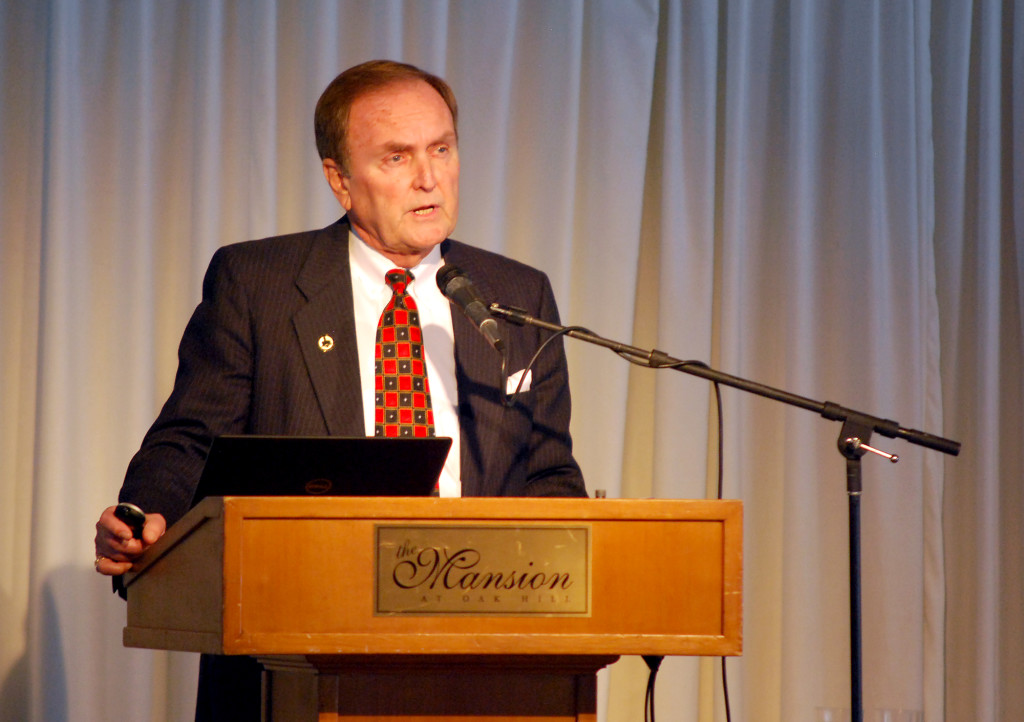
Public safety was the focus of Hamilton County Commissioner Steve Dillinger during his annual “State of the County” address at the Noblesville Chamber of Commerce luncheon on Jan. 22.
“The recent home invasion incidents have created some unrest,” he said. “More than half of the inmates in the county jail the past several years have addresses outside of Hamilton County – most are from Indianapolis. Stats since 2002 show we have stayed very steady with our crime element in Hamilton County.”
To ensure public safety, Hamilton County has and is taking several steps to improve. Dillinger said the costs and inefficiencies of multiple communications centers led to the combination of the three 911 dispatch centers within Hamilton County last year. Carmel’s center cost citizens an extra annual cost of $1,8 million a year. In Noblesville the amount was $1.1 million of extra costs. Mike Snowden was hired as the new county director to oversee the convergence, 67 communications employees and manage the $7.2 million budget.
“The dispatch center received 259,000 calls for service in 2013,” Dillinger said.
In addition to the dispatch center, Hamilton County is replacing its communication system.
“There are multiple radio system types throughout the county,” Dillinger said. “Radio ‘dead spots’ put our public servants in peril.”
Dillinger said the $9 million project adds four new towers (eight total) and more than 2,700 in new radios.
“This is a major step toward public safety and the safety of our public servants,” he said, adding that places in the north part of the county or west Clay Township have radio signal troubles.
Westfield owns 98 acres adjacent to River Road in Noblesville that is proposed to create a countywide public safety training center, which would be used for shooting, water and fire rescue and joint training exercises. While the project has a $11 to $12 million price tag, Dillinger said the anticipated operational costs would be $324,000 to $377,000 with $1.19 million bond payments per year. The center would offset the costs of sending employees across the state and country for training and could be leased to other agencies looking for a training facility.
“I’ll have an update in the next year,” Dillinger said on the proposal.
The latest challenge was the massive winter storm earlier this month that included multiple layers of snow, 40 mph wind gusts, heavy drifting and temperatures that reached 30 below with the wind chill.
“This is a condition that is very, very deadly and very unsafe,” he said. “The storm was unique. Many employees worked 12-hour shifts.”
The storm shut down cities and the county for two days and required round the clock plowing. Because of the conditions, Dillinger and his fellow commissioners declared Hamilton County a disaster.
“We’re hoping to qualify for FEMA funds,” he said. “We spent $1.1 million in that event and are hoping for a 75 percent reimbursement for the county and cities.”
Other highlights of Hamilton County Commissioner Steve Dillinger’s speech include:
• Hamilton County has a rainy day fund of $48,281,000. “Most counties would die for that kind of surplus,” Dillinger said.
• Construction to extend 146th Street west from Spring Mill to Ditch roads is expected to start this year.
• The county is looking at major upgrades of 146th Street at Ind. 37 and Allisionville Road. Dillinger said that if left alone, “it will take 20 minutes to get through each intersection” in 18 years or less.
• The roundabout at 209th Street and Hague Road will be started and hopefully completed this year.
• A study is looking at creating a ramp off 146th Street to Keystone Avenue using Lowe’s Way.
• While the county looks at land outside of Noblesville, it decided to create additions downtown to handle growth. The unique challenge provides two requirements: the addition should look like it was initially built that way and the state only allows $12 million to be used for construction without a referendum.
• County Commissioner Mark Heirbrandt has investigated a solar panel project similar to the one at the Indianapolis International Airport. Dillinger said the $13 million investment proposed by Johnson Melloh Solutions will install the panels on the top of the courthouse, jail and other county buildings. “With projected $33 million energy cost savings over 25 years,” he said. “Hamilton County will become a leader in sustainable energy initiatives. The environmental benefit is the same as planting 22,500 acres of trees.”



